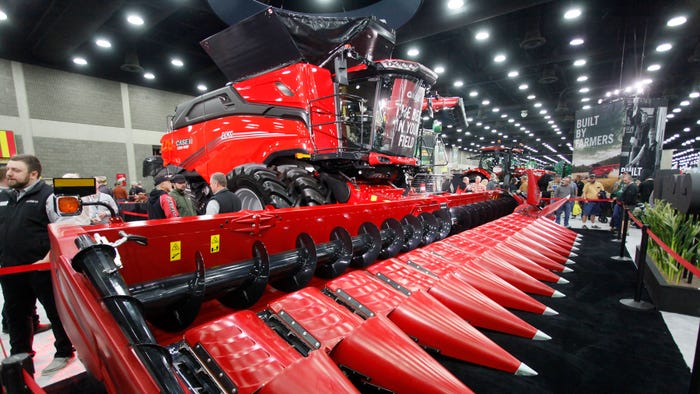February 16, 2024

As the nation’s largest indoor farm show, navigating the National Farm Machinery Show’s showroom floor in Louisville, Ky., is a unique experience. More than 800 exhibitors display thousands of agricultural products. Each tries their best to grab the attention of the roughly 300,000 showgoers who annually attend.
“Let’s see what you’ve got,” says Anthony Welty, category director at Woods Equipment Co., as a showgoer drops a faux coin into a machine to try and win a prize. The coin bounces its way to the bottom.
“Under the ‘Easy maintenance’ category, you’ve got a grease towel!” Welty announces.
Beyond Woods Equipment’s booth, a winding line of attendee hopefuls wait for their turn to win a prize and interface with Woods’ latest 15-foot-long Batwing Flex-Wing Cutter.
“We inverted the batwing all the way back in 1963. You always want to keep challenging yourself to bring newness,” Welty says, noting it’s difficult “to figure out what matters to the end users.”
For engineers at Woods Equipment, reducing maintenance time on the Batwing is a primary area of focus. (Welty highlighted removable blade bolts as an example.) For many of the other manufacturers displaying products on the showroom floor — from tractors to grain dryers — data-related technology is a principal interest for research and development.
Demand for more data
Under the shimmering cast iron, a need for ever more data underpins an unprecedented push by equipment manufacturers to bring the latest advancements to market. There are several trends driving this frenetic expansion.
For one, growers are facing pressure to produce more with less, due to environmental pressures. Meanwhile, experienced producers are handing over the reins of family operations to their children.
“There’s a generational shift happening in agriculture. You’ve got a generation — it might be millennials, it might be Gen Z — that demands technology,” says Joe Shulfer, president of Matthews Co., which manufactures grain dryers. Shulfer was on hand promoting the brand’s remote-monitoring control system, M-C Tracks, among other advancements.
“We can see where the grain is the wettest and where grain is drying faster,” operating “much like a Nest thermostat in your house,” he explains. In the booth next door, Corey Clark, a representative for Apache Sprayers, agrees with Shulfer’s industry assessment.
“A lot of the younger generation that’s taking over these operations is really into technology,” he says.
In Apache’s latest machines — the HS1100 high-clearance sprayer and the AS1050 1,000-gallon sprayer — Clark says they’ve focused on enhancing the driver experience with features like a joystick and display interface, making it easier to control increasingly complex technology that’s beneath the hood.
Evolving environment
These advancements are fundamentally changing the way farmers do their work. While manufacturers might be working with the digital-first expectations of younger farmers in mind, millennial and Gen Z farmers aren’t the only ones who benefit. A few years ago, for example, Mike Keisling, a veteran cattle farmer from Hart, Tenn., bit the bullet and invested in a new tractor.
“If I had known it was that nice, I would have bought it earlier,” he says. “I can go feed in the wintertime in my short sleeves.”
Keisling was taking a break in the show’s cafeteria with Phillip Kyle, another Tennessee cattle farmer. Back in the 1970s, when Kyle first started coming to the National Farm Machinery Show, he says the premiere showcase tractors boasted around 120 hp. Now, they’re pushing into the 700-hp range.
But while today’s farm shows might look a lot different, the mission of innovation remains the same. The biggest challenge today that equipment must overcome, Kyle says, are competitive pressures to access more farmland.
“You always try to do more with less,” he says. However, “you can’t maximize land if it isn’t there.”
About the Author(s)
You May Also Like






